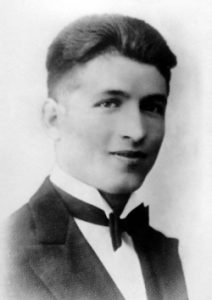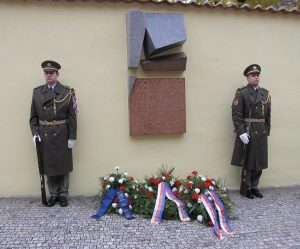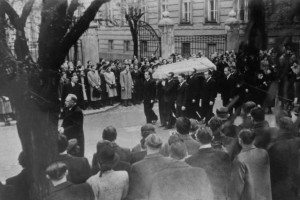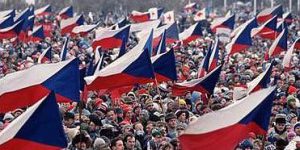Jan Opletal: Dying for democracy during the Occupation
 On October 28, 1939, eight months after the Nazis had taken over the Czech lands, the last big demonstration of anti-Nazi resistance resulted in medical student Jan Opletal’s death. His funeral would become a huge protest against the Occupation that had destroyed Czechoslovakia. The consequences of the demonstrations would be harsh, even brutal, as the Nazis unleashed terror in Bohemia and Moravia.
On October 28, 1939, eight months after the Nazis had taken over the Czech lands, the last big demonstration of anti-Nazi resistance resulted in medical student Jan Opletal’s death. His funeral would become a huge protest against the Occupation that had destroyed Czechoslovakia. The consequences of the demonstrations would be harsh, even brutal, as the Nazis unleashed terror in Bohemia and Moravia.
Childhood and university days
Jan Opletal was born on January 1, 1915, to the Social Democrat-oriented Anna and Štěpán in Lhota nad Moravou during an oppressive era when the Austrians imposed the German language and traditions upon Czechs in the Austro-Hungarian Empire. Opletal was three years old when Czechoslovakia was founded on October 28, 1918, and the Czechs and Slovaks were finally liberated from Austria’s tight reins. Opletal was the youngest in his family; he had seven older sisters. Opletal attended elementary school in Nákle u Olomouce and graduated with honors from a high school in nearby Litovel in 1934. He did his military service as a horse soldier in Prague’s Ruzyně after being rejected for flight school due to insufficient eyesight. He began to study medicine at Charles University in 1936 and lived in the Hlávek dormitory, which was usually reserved for students who had already achieved stellar academic performances. He served as deputy chairman for the student governing body at the dormitory. While at university, Opletal got engaged to Marie Kafková. Growing up during Czechoslovakia’s independent days, he was a strong believer in democracy.
October 28, 1939
Hitler destroyed Czechoslovakia when the Nazis marched into Prague on March 15, 1939, and triggered a time of terror in the Czech lands and Moravia, called the Protectorate of Bohemia and Moravia. On the anniversary of the founding of democratic Czechoslovakia, October 28, 1939, 100,000 people filled the downtown streets of Prague, protesting the Occupation. By early evening on that fateful day, Wenceslas Square, the Tomb of the Unknown Soldier on Old Town Square, and other memorials around the city were covered in flowers and the red, white, and blue colors of the Czechoslovak flag, banned by the Germans. Tea candles were lit as Czechs yelled, “Get out, Germans!”, “We want freedom!”, and “Go away, Hitler!” among other chants.
The Germans fight back
 At six o’clock, as the National Theatre was preparing for a production of William Shakespeare’s Macbeth, German soldiers tried to brutally put an end to the unrest and shot some civilians near Wenceslas Square. In Žitná street Opletal got a bullet in the stomach and was taken to the hospital at Charles Square, where he died on November 11, 1939, at 11:45 in the morning. But he was not the only one to die. The 22-year-old workman Václav Sedláček expired almost immediately after being shot on Mezibranská Street, but he seems to have been largely forgotten. On that tragic day, the Nazis showed their true, horrific colors. Now in Žitna Street, there is a memorial to Opletal at the place he was shot (see photo).
At six o’clock, as the National Theatre was preparing for a production of William Shakespeare’s Macbeth, German soldiers tried to brutally put an end to the unrest and shot some civilians near Wenceslas Square. In Žitná street Opletal got a bullet in the stomach and was taken to the hospital at Charles Square, where he died on November 11, 1939, at 11:45 in the morning. But he was not the only one to die. The 22-year-old workman Václav Sedláček expired almost immediately after being shot on Mezibranská Street, but he seems to have been largely forgotten. On that tragic day, the Nazis showed their true, horrific colors. Now in Žitna Street, there is a memorial to Opletal at the place he was shot (see photo).
November 15, 1939
 Before Opletal’s casket was taken to Moravia for a private, family occasion, a funeral was held in Prague on November 15 as black flags flew from all the university dormitories in the city. A large crowd, including many students, turned out as the official goodbye transformed into a spontaneous demonstration at Prague’s Albertov. While the coffin was placed in the hearse, in which it would be transported to the train station and then to Moravia, Czechs burst out into the Czechoslovak national anthem, “Where is my home?” The protestors yelled, “Get out, Hitler!” and “Go away, Germans!” Yet Prague was not the only Czech city where anti-Nazi demonstrations took place. In Ostrava, Pilsen, Hradec Králove, Příbram and other towns protests also sprung up. The Prague rebellion would be the last big demonstration against the Nazis in the Protectorate.
Before Opletal’s casket was taken to Moravia for a private, family occasion, a funeral was held in Prague on November 15 as black flags flew from all the university dormitories in the city. A large crowd, including many students, turned out as the official goodbye transformed into a spontaneous demonstration at Prague’s Albertov. While the coffin was placed in the hearse, in which it would be transported to the train station and then to Moravia, Czechs burst out into the Czechoslovak national anthem, “Where is my home?” The protestors yelled, “Get out, Hitler!” and “Go away, Germans!” Yet Prague was not the only Czech city where anti-Nazi demonstrations took place. In Ostrava, Pilsen, Hradec Králove, Příbram and other towns protests also sprung up. The Prague rebellion would be the last big demonstration against the Nazis in the Protectorate.
November 17, 1939
Yearning for revenge, during the night of November 17, irate Germans stormed all university dormitories in Prague and in other towns as well, beating and arresting thousands of sleepy, defenseless students, who were then taken to the prison in Pankrác and then to the military barracks in Ruzyně. Nine leaders of student unions were executed on November 17, in the first executions without trials during the Occupation, but certainly not the last. Over 1,000 students were sent to the Sachsenhausen concentration camp near Berlin.
More consequences
After the November 15 demonstration, Hitler announced that all Czech universities and dormitories would be closed for three years. In his speech, he proclaimed that on October 28 and November 15, he should have treated the Czechs as he had the Poles.
Death and survival
Some 35 students died in Sachsenhausen, while 121 university students passed away overall in concentration camps during the war. Those who survived were freed from December of 1939, with the last one let out in March 1943.
Remembering Jan Opletal
In memory of the horrors and bloodshed of November 17, 1939, this date was declared International Students’ Day and is a holiday in the Czech Republic. Opletal is buried in Nákle, Moravia, and there is a memorial to him there as well. Streets in many towns bear his name. In 1996 Czech President Václav Havel awarded Opletal the First Class Order of Tomáš G. Masaryk medal. But Sedláček seems to have disappeared without a trace. Because all his relatives died during World War II, no one took care of his grave. In 1965 his grave was abolished, and the plot was sold to someone else.
Standing up for freedom
During the October 28 and November 15 demonstrations, Czechs stood up to the oppressive Reich that had destroyed their independent Czechoslovakia. Unified, they stood up for freedom and all democratic ideals. They showed the Nazis that they would not go down without a fight. The Nazis demonstrated the horrific means by which they were willing to stop any resistance. Bloodshed and brutality would become commonplace during the Occupation, and democracy was definitely dead.
Wenceslas Square and monuments to Jan Palach and Jan Opletal
 In 1969 another university student became a Czech martyr. That year, Jan Palach set fire to himself on Wenceslas Square in protest of the rigid changes of the normalization period, when Communist order was restored after the crushing of the liberal reforms during the so-called 1968 Prague Spring. Even though Palach was demonstrating against Communism, both he and Opletal became martyrs of a cause opposing occupants who had squashed Czech nationalists. A memorial to Palach can be viewed in front of the statue of Saint Wenceslas on Wenceslas Square, and a plaque commemorating him appears on the front of the Philosophical Faculty of Charles University, where he studied. One of the streets entering Wenceslas Square is named after Opletal. The Velvet Revolution is also tied to Jan Opletal. It started on November 17, 1989, when police brutally suppressed students in a demonstration commemorating the fiftieth anniversary of the closing of Czech universities by the Nazis. At times one death can serve as a catalyst for popular rebellion – whatever are the results of the rebellion itself.
In 1969 another university student became a Czech martyr. That year, Jan Palach set fire to himself on Wenceslas Square in protest of the rigid changes of the normalization period, when Communist order was restored after the crushing of the liberal reforms during the so-called 1968 Prague Spring. Even though Palach was demonstrating against Communism, both he and Opletal became martyrs of a cause opposing occupants who had squashed Czech nationalists. A memorial to Palach can be viewed in front of the statue of Saint Wenceslas on Wenceslas Square, and a plaque commemorating him appears on the front of the Philosophical Faculty of Charles University, where he studied. One of the streets entering Wenceslas Square is named after Opletal. The Velvet Revolution is also tied to Jan Opletal. It started on November 17, 1989, when police brutally suppressed students in a demonstration commemorating the fiftieth anniversary of the closing of Czech universities by the Nazis. At times one death can serve as a catalyst for popular rebellion – whatever are the results of the rebellion itself.




